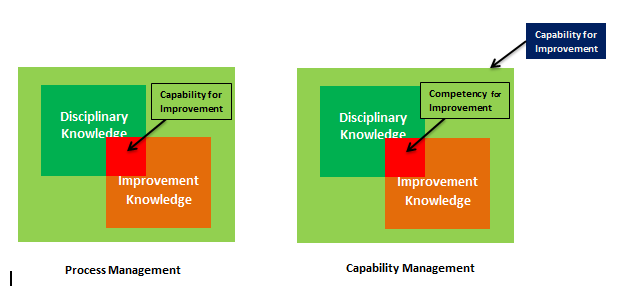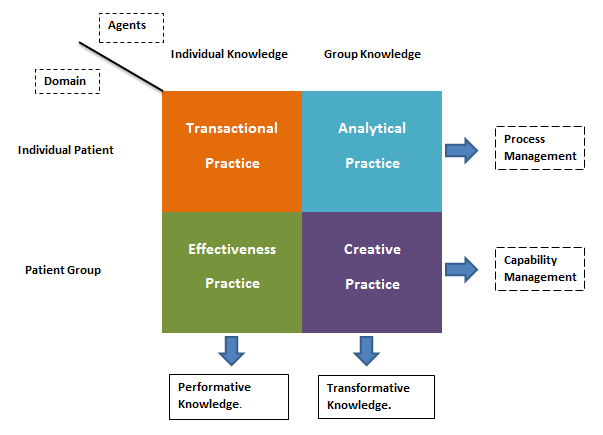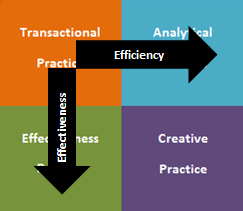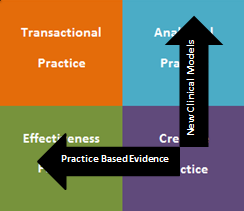Improvement Science is the adoption of profound knowledge to healthcare practice.Profound Knowledge as a theory of Improvement is concerned with both performance and transformation. However, the knowledge , the ethos and substrate of performance and transformation are different. While mechanical production systems can allow descriptions such as online and offline quality, interactive , adaptive processes of care provision are better described as performative and transformative. These two domains of improvement differ on being ‘Decision Centric’ and ‘Design Centric’, respectively. Such a distinction has implications for the analysis of practice, the development of knowledge bases and the approach to deployment of quality methodologies.
Traditional practice of medicine has been an interaction between a single patient and single professional. The outcomes in this mileu has been dependent on the competence and skill of the physician. This is the most elemental level of analysis . Specialization of knowledge and organization of care now is by multiple agents taking care of a single client and thus requires more explicit focus on process. Any understanding of outcome requires analysis of several ‘patient – professional ‘ or ‘client- agent ‘units. The above analysis of practice is ahistorical, in the sense it is descriptive and thus does not accord special status to process based view. Rather, it looks at process methodologies as being incomplete , both with regards to implementation and understanding of participation. The creative practice model does not offer a single trajectory but posits ‘creative practice’ as an ideal for the remaining three mental models to migrate towards.The model does not view QA and QI as polemical and thus permits multiple modes of inquiry. It encourages the expansion of the creative practice paradigm as a meta- system, rather than the collapse of the other quadrants. Thus transformative knowledge includes performative knowledge , the capability approach includes process management.The underlying techtonic shift, from transactional practice to creative practice, is from substantive rationality to communicative rationality.
If we accept the IOM definition of effectiveness as the application of best avaible evidence , then implementation focuses on several groups made up of more or less identical ‘client-agent ‘ units. For, example groups may be made of patients with particular diagnosis, undergoing particular procedures, belonging to certain age-groups or receiving care in particular intervals of time or definite locations. While the methodology for assessment of outcome is the same as that in individual transaction based practice , the inference of performance is drawn from groups . Traditional statistical methods are often sufficient and reliable. The overall aim is confirmation and the motivation is individual accountability. Such ‘confirmatory research’ often views innovation in local practice as aberration.This domain of improvement knowledge –in the transaction and effectiveness perspective is called Performative Knowledge.
While there are significant criticisms of the positivist paradigm of evidence based medicine, both on practical and philosophical grounds , much of the solutions offered are usually atavistic. For example, calls to incorporate experience , patient values , basic sciences.etc. Such suggestions , however remain within the transactional , effectiveness practice domains and have failed to acknowledge the impact of recent developments of process analysis and innovation on practice.The central idea of creative practice is the inclusion of ‘ideas ‘ along with ‘ evidence’ in the design of practice.
In Manufacturing, design refers the pre-execution plan to meet customer requirements, is concerned with product development and thus is pre-systemic. It is an enduring object. In interactive environments such as healthcare it is meta-systemic. It is a perduring object. This description is borrowed from the theory of mereological essentialism, regarding the persistence of objects over time: objects that persist by being wholly present every instant, means that the enduring objects only have their spatial parts essentially. Perduring objects on the other hand are objects that are spread out with parts both in space and time and thus have also their temporal parts essentially in addition to their spatial parts. [David Kellogg Lewis -1986].
By retaining, the transactional and effectiveness quadrants , the centrality of patient – professional relationship is maintained. Similarly, the analytic approach is a reality of practice but has its own problems of co-ordination and in creating motivation for change that is both effective and creative. Without the notion of Effectiveness Practice, Transaction practice is not performative, similarly without acknowledgment of Creative practice , Analytical practice is not transformative. In the Creative Practice model “vertical” direction seeks to reconstruct fundamental and important competencies, by engaging two distinctive modes of understanding of the deep ‘generative structure’ of practice, as performative and transformative , whereas the “horizontal” direction seeks to reconstruct the logic of the genetic development of these competencies as processes and capabilities.
The development of the ‘effectiveness’ arm is concerned with ‘ doing the right things’; the extension of transaction to analytical results in efficiency or ‘ doing things right’. Analytical Practice views clinical work as a ‘production system’ and the unit of examination is ‘activities’, while in the effectiveness practice views clinical work as a ‘performance system’ and the unit of analysis is ‘evidence-acts’. A less technical formulation of the model would be as follows: the effectiveness arm is about ‘ what ‘ ; the efficiency arm is about ‘ how ‘ and creative practice is motivatted by ‘why’.
Performative and transformative are not binaries but a continuum. The degree to which the change is systemic as well as the extent to which, the charter for change is with those who conceptualize the outcomes. While performative knowledge is about working in the system, transformative knowledge is about working on the system. However, creative practice implies that change to the system is made by those who work in the system. Similarly, the capability approach preserves effectiveness practice and creative practice and is distinct from the process approach, that mandates change from above. The relationship between performative and transformative knowledge can be viewed hypothetically as below:
In the second edition of their book Nolan et al offer a minimalistic introduction to the idea of capabilities. Even though they leave their description open ended, their view actually limits capability to competence.
 Nolan et al description of capability seems to match well with Batalden’s idea of professional development as both of them are in the process management paradigm.It is closely linked to and limited by related idea of capacity or critical mass. In the capability management approach , the intersection is treated as competency for improvement. The idea of capability is overarching as a universal and not merely the competency of individual groups. The former characterization may be adequate for developed countries with a rich legacy of quality and healthcare service research. In the case of developing countries capability is best treated as a ‘superstructure’.
Nolan et al description of capability seems to match well with Batalden’s idea of professional development as both of them are in the process management paradigm.It is closely linked to and limited by related idea of capacity or critical mass. In the capability management approach , the intersection is treated as competency for improvement. The idea of capability is overarching as a universal and not merely the competency of individual groups. The former characterization may be adequate for developed countries with a rich legacy of quality and healthcare service research. In the case of developing countries capability is best treated as a ‘superstructure’.
The redefinition of professional accountability as ‘doing one’s work’ and ‘improving one’s work’ is legitimate , but does not offer clarification of the current state of practice. It does not sufficiently deconstruct the status quo. It does not alert us to the chasm between the two imperatives ‘do your work’ and ‘improve your work’; Performative practice is largely ‘improvement by practice’, which most of the current practioners in healthcare are aware of and believe to be sufficient.On the other hand, tranformative practice is about ‘improvement of practice’.
The creative practice model is offered as a gentle redefinition of the concept of practice and to create room for the ‘justification of ideas’. It is a search for ontological validity of improvement knowledge. The quadrants in the model should not be seen as compartments, but as holding a meronomic relation to creative practice. An ideal practice is transactional, analytical , effective and creative.
The foundational idea of creative practice is the belief that there is always a better way of doing things which has to be discovered in practice.
1



